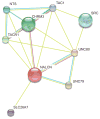Phenotypic evolution of UNC80 loss of function
- PMID: 27513830
- PMCID: PMC5671762
- DOI: 10.1002/ajmg.a.37929
Phenotypic evolution of UNC80 loss of function
Abstract
Failure to thrive arises as a complication of a heterogeneous group of disorders. We describe two female siblings with spastic paraplegia and global developmental delay but also, atypically for the HSPs, poor weight gain classified as failure to thrive. After extensive clinical and biochemical investigations failed to identify the etiology, we used exome sequencing to identify biallelic UNC80 mutations (NM_032504.1:c.[3983-3_3994delinsA];[2431C>T]. The paternally inherited NM_032504.1:c.3983-3_3994delinsA is predicted to encode p.Ser1328Argfs*19 and the maternally inherited NM_032504.1:c.2431C>T is predicted to encode p.Arg811*. No UNC80 mRNA was detectable in patient cultured skin fibroblasts, suggesting UNC80 loss of function by nonsense mediated mRNA decay. Further supporting the UNC80 mutations as causative of these siblings' disorder, biallelic mutations in UNC80 have recently been described among individuals with an overlapping phenotype. This report expands the disease spectrum associated with UNC80 mutations. © 2016 Wiley Periodicals, Inc.
Keywords: emaciation; failure to thrive; growth restriction; intellectual disability; seizures.
© 2016 Wiley Periodicals, Inc.
Conflict of interest statement
There are no conflicts of interest to declare.
Figures



References
-
- Al-Sayed MD, Al-Zaidan H, Albakheet A, Hakami H, Kenana R, Al-Yafee Y, Al-Dosary M, Qari A, Al-Sheddi T, Al-Muheiza M, Al-Qubbaj W, Lakmache Y, Al-Hindi H, Ghaziuddin M, Colak D, Kaya N. Mutations in NALCN cause an autosomal-recessive syndrome with severe hypotonia, speech impairment, and cognitive delay. Am J Hum Genet. 2013;93(4):721–726. - PMC - PubMed
-
- Aldridge VK, Dovey TM, Martin CI, Meyer C. Identifying clinically relevant feeding problems and disorders. J Child Health Care. 2010;14(3):261–270. - PubMed
-
- Bone WP, Washington NL, Buske OJ, Adams DR, Davis J, Draper D, Flynn ED, Girdea M, Godfrey R, Golas G, Groden C, Jacobsen J, Kohler S, Lee EM, Links AE, Markello TC, Mungall CJ, Nehrebecky M, Robinson PN, Sincan M, Soldatos AG, Tifft CJ, Toro C, Trang H, Valkanas E, Vasilevsky N, Wahl C, Wolfe LA, Boerkoel CF, Brudno M, Haendel MA, Gahl WA, Smedley D. Computational evaluation of exome sequence data using human and model organism phenotypes improves diagnostic efficiency. Genet Med 2015 - PMC - PubMed
-
- Chatoor I. Diagnosis and Treatment of Feeding Disorders in Infants, Toddlers, and Young Children. Washington: National Center for Clinical Infant Programs; 2009.
-
- Chong JX, McMillin MJ, Shively KM, Beck AE, Marvin CT, Armenteros JR, Buckingham KJ, Nkinsi NT, Boyle EA, Berry MN, Bocian M, Foulds N, Uzielli ML, Haldeman-Englert C, Hennekam RC, Kaplan P, Kline AD, Mercer CL, Nowaczyk MJ, Klein Wassink-Ruiter JS, McPherson EW, Moreno RA, Scheuerle AE, Shashi V, Stevens CA, Carey JC, Monteil A, Lory P, Tabor HK, Smith JD, Shendure J, Nickerson DA, Bamshad MJ University of Washington Center for Mendelian G. De novo mutations in NALCN cause a syndrome characterized by congenital contractures of the limbs and face, hypotonia, and developmental delay. Am J Hum Genet. 2015;96(3):462–473. - PMC - PubMed
Publication types
MeSH terms
Substances
Grants and funding
LinkOut - more resources
Full Text Sources
Other Literature Sources
Medical
Molecular Biology Databases

